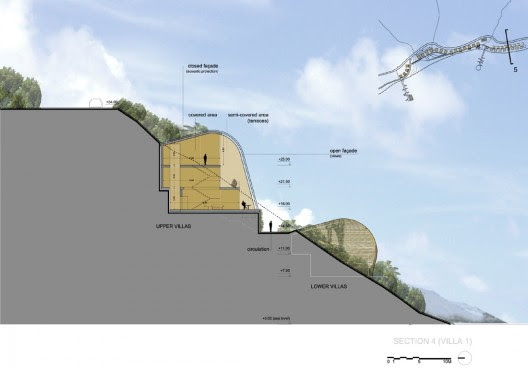
This is a sustainable design for a future development that possibly will be built.
BURO II already built a project of this amplitude in Guangzhou (China) and won with this ‘Baiyun International Convention Centre’ an international prize at the World Architecture Festival in Barcelona in 2008.
The design of this hotel beach resort is a concept whereby a sustainable relationship with the local economy, culture and natural heritage is central. The hotel assimilates with the natural habitat of the island. The development of this exclusive residential resort of 22.000m² is situated along Mero Beach on the west coast of the Commonwealth of
Dominica.
More images and architect’s description after the break.
Mero Beach is one of the most important beaches on the island and has specific and relevant social and ecological values. Both those social and ecological characteristics are related to the fragile cultural, economical and natural balance whose protection is paramount.The design of this resort intends to protect that balance and promote a sustainable development approach. The design reflects a concept whereby a sustainable relationship with the local economy, culture and natural heritage is central. The hotel assimilates with the natural habitat of the island. This means that:
• Privacy and security could be combined with the possibility for authentic local experiences;
• Natural bio-diversity could be enriched rather than destroyed by human activities;
• Tourism could be a lever of a sustainable cultural, social and economical development;
• Resilience and flexibility in design and construction processes could assure economical, social and financial sustainability with a temporal horizon of more than 100 years;
• The impact of the new buildings and activities regarding energy use, water management, waste production and climate could be strongly limited.
Mero Village and the Resort will together form a hub of social and economic activity, drawing in visitors who wish to experience
Dominica’s unique natural and cultural heritage, local food production, crafts and skills. The Resort will benefit from, protect and enhance the nation’s world renowned rainforest, coastal and wetland habitats and indigenous species. As far as practicable, food, goods and services will be sourced locally. As a new cultural and business model for hospitality and regeneration, Mero Beach Resort will inspire and inform future developments towards sustainability.
Clients, operators, designers and contractors are engaged during the design, construction and management processes in the conception and enforcement of an appraisal framework which will aim towards a LEED certification.
Architecture and nature
The goal of the project is to create a dialogue with the existing context: the nature and the village. The main characteristics of the site are: the presence of the beach, the thick foliage all along the long and thin beachfront plot, the topography from flat to steep, the river and ravine and the proximity of Mero village.
The concept is to create a linear path as the central spine of the project. This promenade will connect several functions creating a smooth transition from public to private. The beach will become in this manner ‘equipped’, featuring different grades of openness for guests and visitors. The local public road integrated in the project and transformed into a village “boulevard”, marina, shops, ecopark, reception, congress hall, parking, fitness, spa, restaurant and beach club among others.
A Priori, the high density of the program has to be distributed in a way that minimizes the impact of the development within this sensitive location. The program has been divided into several integrated volumes creating an equated rhythm of sound (building) and silence (mountain). The developmental strategy is governed by a system that mediates volumetric form with local topography.
The project contains a mixture of uses including: villas, bungalows and apartments, retail, entertainment, hotel, conference facilities and parking.
The use of sustainable materials and techniques and the predominance of natural vegetation strengthen the concept of architectural integration within a natural environment. Always framed by the local vegetation and sea views, the new development will become a new landmark for the coastline of
Dominica without overshadowing its existential essence: the Nature.
-

-

-

-

-

-

-

-

-

-

-

-

-

-

-
